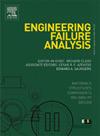Ti-6Al-4V合金多向等温锻造组织演变及断裂机制
IF 4.4
2区 工程技术
Q1 ENGINEERING, MECHANICAL
引用次数: 0
摘要
研究了多向等温锻造(MDIF)对Ti-6Al-4V合金显微组织、力学性能和断裂行为的影响。MDIF工艺使合金晶粒细化,屈服强度和抗拉强度分别达到1245 MPa和1267 MPa,比铸态提高29%和22%。断裂行为表现为韧性断裂特征,位错在晶界处聚集,引起应力集中,促使晶界处裂纹的形成和扩展,最终通过颈缩连接。有限元模拟进一步阐明了断口表面的应力分布,应力主要集中在断口附近。这项工作为优化Ti-6Al-4V的工艺以实现高性能应用提供了关键见解,并为通过晶粒细化提高强度和韧性提供了有价值的指导。本文章由计算机程序翻译,如有差异,请以英文原文为准。
Microstructure evolution and fracture mechanisms in Ti-6Al-4V alloy under multidirectional isothermal forged
This study investigated the effects of multidirectional isothermal forging (MDIF) on the microstructure, mechanical properties, and fracture behavior of Ti-6Al-4V alloy. The MDIF process significantly refined the grain size, leading to substantial increases in yield strength and tensile strength, reaching 1245 MPa and 1267 MPa, respectively, which represent 29 % and 22 % increases compared to the as-cast alloy. The fracture behavior exhibited characteristics of ductile fracture, with dislocations accumulating at grain boundaries causing stress concentration, which promotes the formation and propagation of cracks along the grain boundaries, ultimately connecting through necking. Finite element simulation further elucidated the stress distribution on the fracture surface, showing that stress was mainly concentrated near the fracture surface. This work provides key insights for optimizing the processing of Ti-6Al-4V to achieve high-performance applications and offers valuable guidance for enhancing strength and toughness through grain refinement.
求助全文
通过发布文献求助,成功后即可免费获取论文全文。
去求助
来源期刊

Engineering Failure Analysis
工程技术-材料科学:表征与测试
CiteScore
7.70
自引率
20.00%
发文量
956
审稿时长
47 days
期刊介绍:
Engineering Failure Analysis publishes research papers describing the analysis of engineering failures and related studies.
Papers relating to the structure, properties and behaviour of engineering materials are encouraged, particularly those which also involve the detailed application of materials parameters to problems in engineering structures, components and design. In addition to the area of materials engineering, the interacting fields of mechanical, manufacturing, aeronautical, civil, chemical, corrosion and design engineering are considered relevant. Activity should be directed at analysing engineering failures and carrying out research to help reduce the incidences of failures and to extend the operating horizons of engineering materials.
Emphasis is placed on the mechanical properties of materials and their behaviour when influenced by structure, process and environment. Metallic, polymeric, ceramic and natural materials are all included and the application of these materials to real engineering situations should be emphasised. The use of a case-study based approach is also encouraged.
Engineering Failure Analysis provides essential reference material and critical feedback into the design process thereby contributing to the prevention of engineering failures in the future. All submissions will be subject to peer review from leading experts in the field.
 求助内容:
求助内容: 应助结果提醒方式:
应助结果提醒方式:


